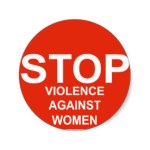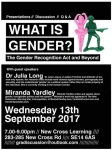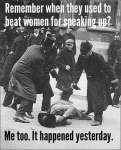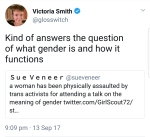HOW LEGISLATION PROTECTS WOMEN-ONLY SPACES AND SERVICES:
AN OVERVIEW
by Louise Whitfield, Public Law Specialist and Partner at Deighton Pierce Glynn
Click here for a PDF version of this legal briefing
INTRODUCTION
This briefing is designed to highlight the existence of legal protections for women-only activities, spaces and services to help ensure that these rights are properly understood and to avoid misinterpretation that may threaten their existence. The following topics are dealt with below:
- Summary of what is and isn’t covered by the Equality Act 2010
- When discrimination is lawful
- Women-only associations
- When discrimination against women-only events is unlawful
- The legal responsibilities of public bodies
This briefing does not detail all the protections available under the Equality Act 2010 for all groups in all areas – or set out the principles which underpin the Act – except where it is relevant to the rights of women. It is designed to be understood by non-lawyers. Further information is also provided in appendices in terms of the specific provisions of the Act and other resources.
WHAT IS AND ISN’T COVERED BY THE EQUALITY ACT 2010
The Equality Act 2010 is the main piece of law in England, Wales and Scotland to protect particular groups from disadvantage or unfair treatment*. It bans discrimination against certain groups in certain activities. Discrimination essentially means treating people less favourably because of a “protected characteristic”. A protected characteristic means someone is entitled to legal protection on the grounds of a particular feature, for example their sex.
The list of protected characteristics is set out in section 4 of the Equality Act and can be found in appendix 1 of this briefing, along with definitions of the main types of discrimination that are relevant: direct, indirect and harassment.
Biological sex and gender re-assignment are two of the relevant ‘protected characteristics’ as they relate to women-only spaces and services.
The specific areas or activities covered by the different parts of the Act that are relevant are:
- services and public functions
- premises
- work
- education
- associations
Anti-discrimination laws do not cover anything else you do or plan to do. Private activities are NOT covered by these anti-discrimination laws.
*1. The Equality Act 2010 does not apply in Northern Ireland which has a range of different pieces of legislation prohibiting discrimination.
WHEN DISCRIMINATION IS LAWFUL
Generally, the Equality Act doesn’t allow for discrimination against those with ‘protected characteristics’ who want to use a service. However, there are exceptions in certain circumstances.
If you are providing a service, you can provide it for women only under paragraph 27 of Schedule 3 of the Act (which is set out in Appendix 2). This states that if the targeted provision is a proportionate means of achieving a legitimate aim and the services meet ONE of six conditions (for example only people of that sex need the service), it is lawful to provide it to women only. You can find all the conditions in Appendix 2.
In addition, paragraph 27 makes clear that, if a public body exercises a public function relating to the provision of a single-sex service, they are also covered by these exceptions. This covers “back-room” activities and decisions, about administration, management and finance. So a local authority funding a women-only refuge can do this lawfully; or they can let women’s groups use their buildings or facilities to provide women-only services.
The examples for lawful single-sex services given in the notes that were published with the Equality Act include the following:
• a cervical cancer screening service to be provided to women
only, as only women need the service;
• a domestic violence support unit to be set up by a local
authority for women only but there is no men-only unit
because of insufficient demand;
• separate male and female wards to be provided in a hospital;
• separate male and female changing rooms to be provided in
a department store;
• a massage service to be provided to women only by a female
massage therapist with her own business operating in her
clients’ homes because she would feel uncomfortable
massaging men in that environment.
Women’s projects or organisations may find guidance from the Equality & Human Rights Commission useful. This is because they explain how it is lawful to provide single-sex services; (see the link in Appendix 4 to “What equality law means for your business”, specifically pages 16 and 17).
Paragraph 28 of Schedule 3 of the Act also makes it lawful to refuse to provide single-sex services to someone on the basis of their gender reassignment. Again
this needs to be objectively justified – the provision of single-sex services must be a proportionate means of achieving a legitimate aim. The example given in the explanatory notes that accompany the Equality Act is as follows:
“A group counselling session is provided for female victims of sexual
assault. The organisers do not allow transsexual people to attend as
they judge that the clients who attend the group session are unlikely to
do so if a male-to-female transsexual person was also there. This
would be lawful.”
This issue is also covered in the EHRC’s guidance at page 17 which is relevant to women’s projects or organisations providing single-sex services: “Although a business can exclude a transsexual person or provide them with a different service, this is only if it can objectively justify doing so”. “Objective justification” means that you have a legitimate aim (a good reason) for providing a particular service, and that making it women only is a proportionate (reasonable – not ‘over the top’) way of meeting that aim. For example, a domestic violence organisation might have a legitimate aim of ensuring women feel safe because otherwise they will not want to access the services, and it would be proportionate to restrict your service to females to ensure that it is effective.
A WOMEN-ONLY ASSOCIATION
Women can lawfully associate together in different ways. A formal association is only covered by the Equality Act if it has more than 25 members and a membership system involving a process of selection and rules. If a group has fewer than 25 members, or doesn’t have rules, the group isn’t affected by the Act, so for example you can run a book group or have a private party however you like. A group of women wanting to come together informally at a private gathering is not in breach of the Equality Act if they decide to turn away men.
This is set out in the guidance from the Equality & Human Rights Commission called: “What equality law means for your association, club or society”. At page 11 it gives examples of “a book-reading club run by a group of friends; a walking club which anyone who finds out about it can belong to; a choir which is open to anyone who works at a particular place but where no approval is required to join” and then states: “This sort of informal ‘club’ is not covered by equality law at all.”
Ordinarily if a women-only association has more than 25 members and a membership system, it cannot discriminate against people on the basis of a protected characteristic, as this is prohibited under the Act, but there are exceptions.
Even if the group you set up is a formal association, with membership rules etc and has more than 25 members, you are not discriminating against someone if membership is restricted to having a particular characteristic: a women-only association does not discriminate against a man by not letting him join. You can also restrict guests to people with particular protected characteristics. This is the exception that is set out at paragraph 1 of Schedule 16 of the Act (see Appendix 2). The notes that come with the Act explain:
“This paragraph allows an association whose main purpose is to
bring together people who share a particular characteristic (such
as a particular nationality, sexual orientation or a particular
disability) to continue to restrict membership to such people, and
impose similar restrictions on those who can exercise the rights of
an associate, or who can be invited as guests.”
WHEN DISCRIMINATION AGAINST WOMEN-ONLY ACTIVITIES IS UNLAWFUL
If you want to run a women-only event or service, you cannot be discriminated against by another service-provider on the basis that you are women. If an organisation or company managing a venue refuses to let you hire it because you want to hold a women-only event this would be unlawful discrimination by them against you. Under section 13 of the Equality Act 2010, it is discrimination – when providing a service – to treat someone less favourably because of their sex. Therefore, someone running a venue or providing another type of service cannot refuse to let you book it because you are a woman wanting to run a lawful women- only event or service.
By letting you make a booking, the venue provider is not discriminating against anyone else. You are being provided with the premises on the same terms as any other organisation. You are being treated the same as any other hirer, and not in a different way because you are women, so there is no breach of the Equality Act 2010 and therefore no discrimination against anyone else. Men cannot claim that the venue owner letting you use the venue for a women-only event is somehow discriminating against them; this is incorrect in law.
THE LEGAL RESPONSIBILITIES OF PUBLIC BODIES
A public body, or an organisation exercising a public function, must meet the public sector equality duty set out in section 149 of the Equality Act 2010 (which is set out in full in appendix 3). This means that public bodies – for all their functions – and anyone else carrying out a public function must have due regard to the need to:
- Eliminate discrimination and harassment of women;
- Advance equality of opportunity for women;
- Foster good relations between women and men (including tackling prejudice and promoting understanding).
Advancing equality of opportunity for women includes having due regard to the need to:
- Remove or minimise the disadvantages women suffer;
- Take into account women’s needs that are different from men’s needs;
- Encourage women to participate in public life and other activities in which their participation is low.
Examples of when the public sector equality duty applies include:
- Local authorities considering funding women-only groups
- The continuation of single-sex services provided by an NHS trust
- Development of policies and guidance by central Government
- Decisions that only affect one person, such as an application to the council for housing
With all these examples there has to be due regard to the need to eliminate discrimination and harassment of women. There must also be due regard to the need to advance equality of opportunity for women. Public bodies must assess whether there will be an adverse impact on women of a particular decision or policy. They must then decide if that adverse impact can be avoided entirely, reduced or somehow mitigated, or is justified. Other public bodies that must comply with the equality duty include the police, NHS trusts and government agencies (e.g. HMRC).
What “due regard” means in practice
Having “due regard” means considering something proportionately to its relevance to women’s equality. Some issues will be highly relevant to women’s equality (e.g. council provision of free childcare because it has such a significant impact on women’s ability to work etc), while other issues may be less relevant (e.g. a council’s arrangements for waste collection, as that’s likely to have the same impact on men and women and their equality). Issues that are highly relevant for women’s equality will need careful consideration by the public authority so that they have “due regard” to the needs set out in the equality duty (see above).
The Equality & Human Rights Commission explains this in their guidance called “Technical Guidance on the Public Sector Equality Duty: England” (revised in August 2014). At page 19, paragraph 2.20, it states:
“How much regard is ‘due’ will depend on the circumstances and in
particular on the relevance of the aims in the general equality duty to
the decision or function in question. The greater the relevance and
potential impact, the higher the regard required by the duty.”
[emphasis added]
Meeting the equality duty for different groups with different needs
Meeting the public sector equality duty will sometimes involve a balancing exercise on the part of a public body. If there is more than one group to consider in terms of equality then ‘due regard’ should apply to all groups affected. The rights of one group of people with a particular protected characteristic cannot trump the rights of another group. The public body should look at the best way it can eliminate discrimination and harassment, and advance equality of opportunity, for all people who have any of the protected characteristics. There is no hierarchy as to which are more important. Having due regard in respect of equality for one group should not be at the expense of another group protected under the Equality Act.
Attempts to end discrimination for one group must always take into account the on-going statutory duty to have due regard to the need to eliminate discrimination and harassment and advance equality of opportunity for all other groups.
For example when the Law Society took steps to meet the needs of some Muslim clients who might approach their solicitors for advice when they wanted a Sharia- compliant will, the Law Society failed to think about this in terms of gender equality. They should have considered the impact on women when they drafted a practice note on this issue and circulated it to members with no recognition of the potential discrimination that could result. When concerns were raised with them including their failure to comply with the public sector equality duty in terms of gender equality, the practice note was withdrawn and the Law Society issued an apology.
Some public bodies have misinterpreted the Equality Act to mean that they have to treat everybody the same and provide the same services to all different groups. They have misunderstood the public sector equality duty and failed to recognise that they should have “due regard to the need to take steps” to meet women’s needs that are different from men’s needs (see section 149(3)(b), Equality Act 2010). They have also failed to consider that they may need to take steps to remove or minimise the disadvantages that women suffer.
A case study from real life
The case that service-users from Southall Black Sisters (SBS) brought against Ealing Council gives some useful examples of these points. It was all about how support services for people fleeing domestic violence were funded and provided.
The Council rated the services provided by SBS so highly that they wanted them to be available to everyone. So they decided to change how they funded domestic violence support services and how those services should be provided. The Council announced that the new service provider must make the same services available to men and women, from all ethnic backgrounds. The specialist providers in Ealing pointed out that they couldn’t provide their service to men for a variety of reasons. They explained that women would not feel safe; that the service wouldn’t be as effective and so on. The Council backed down on this point at an early stage. They recognised that they had been mistaken to insist that the services be provided to men and women. This is an example of effective lobbying by the women’s sector when faced with a misinterpretation of the equality duty by a public body. The Council thought that they had to provide the same service to everyone but then realised this was incorrect.
However, the Council continued to say that one provider – or one consortium – must provide the same services to all women from all ethnic backgrounds. Initially they did not even check whether this would have an adverse impact on black and minority ethnic women. The Council thought that providing the same generic service to all women would be just as good. They did look at this issue after they’d taken their decisions but the judge said this was too late. The judge also made clear that it was lawful to provide specialist services for different groups with different needs. In fact, he said that this might be necessary to ensure the equality duty is met:
“Ealing’s mistake was to believe … that such [specialist] services
could only lawfully be provided by a single provider or consortium to
victims of domestic violence throughout the borough. It appreciates
that it was in error and that in certain circumstances the purposes of
[the public sector equality duty] may only be met by specialist
services from a specialist source.”
This approach applies equally to the provision of women-only services when public bodies are making decisions about those services. They need to think: how will this decision help to eliminate discrimination and to advance equality for women? Do we need to take steps to remove or minimise the disadvantages women face in this area? How do we take into account women’s needs that are different from men’s needs? How do we encourage women to participate in public life and other activities where their participation is low?
To comply with the public sector equality duty, the public body must gather the information they need to answer these questions. They must then analyse their findings to assess the impact on women. Then they must make a rational decision based on those findings. If they fail to do so, they have breached the public sector equality duty.
CONCLUSION & SUMMARY
- It is lawful to provide women-only services
- It is lawful to organise women-only events
- It can be lawful to exclude men and those with gender re-assignment status and others on the trans spectrum in specific circumstances considered on a case by case basis as set out above
- It is lawful to have a women-only association
- It is unlawful for another service provider to refuse to provide services to you because your event or service is only for women
- It is lawful to ask anyone you like to a private event and to exclude anyone you want to exclude
Some women and women’s organisations have received contradictory information about the points covered in this briefing. If you are concerned about legal action because you are protecting women-only spaces and services, then the following points may be useful:
- If someone says you are acting unlawfully by excluding them, you should provide them with copies of the Equality & Human Rights Commission’s guidance which explains the law and why it is lawful to exclude people in certain circumstances (see page references above and links in appendix 4).
- If someone threatens you with legal action because you have refused them entry to an event, or refused to provide them with a service, they should put this in writing to you and give you the opportunity to respond before they start a court case against you; this gives you the chance to get legal advice on the specific situation and/or re-assess whether you need to change your decision.
- Legal aid may be available for individuals needing advice about these issues or you may be able to negotiate a fixed fee for some initial advice if legal aid is not available.
The Equality and Human Rights Commission may be able to assist (see the links in appendix 4 for their website which has contact details).
Louise Whitfield, Deighton Pierce Glynn June 2016
APPENDIX 1: EXTRACTS FROM THE EQUALITY ACT 2010,
Part 2 – key concepts
Section 4: protected characteristics
The following characteristics are protected characteristics — age; disability; gender reassignment; marriage and civil partnership; pregnancy and maternity; race; religion or belief; sex; sexual orientation.
Section 13: direct discrimination
(1) A person (A) discriminates against another (B) if, because of a protected characteristic, A treats B less favourably than A treats or would treat others.
…..
(6) If the protected characteristic is sex—
(a) less favourable treatment of a woman includes less favourable treatment of her because she is breast-feeding;
(b) in a case where B is a man, no account is to be taken of special treatment afforded to a woman in connection with pregnancy or childbirth.
“Direct discrimination” on the grounds of sex means treating
someone less favourably because they are a woman, for example
stopping someone using a service because they are a woman;
direct discrimination can never be justified but there are
exceptions.
Section 19: indirect discrimination
(1) A person (A) discriminates against another (B) if A applies to B a provision, criterion or practice which is discriminatory in relation to a relevant protected characteristic of B’s.
(2) For the purposes of subsection (1), a provision, criterion or practice is discriminatory in relation to a relevant protected characteristic of B’s if —
(2.a) A applies, or would apply, it to persons with whom B does not share the characteristic,
(2.b) it puts, or would put, persons with whom B shares the characteristic at a particular disadvantage when compared with persons with whom B does not share it,
(2.c) it puts, or would put, B at that disadvantage, and
(2.d) A cannot show it to be a proportionate means of achieving a legitimate aim.
(3) The relevant protected characteristics are — age; disability; gender reassignment;marriage and civil partnership; race; religion or belief; sex; sexual orientation.
“Indirect discrimination” on the grounds of sex means having a
provision, criterion or practice that puts women at a disadvantage in
comparison to men; for example having a policy that only full-time
workers get promotion when more women than men work part-time
so women cannot get promoted; indirect discrimination can be
justified if it is a proportionate means of achieving a legitimate aim.
Section 26: harassment
(1) A person (A) harasses another (B) if—
(a) A engages in unwanted conduct related to a relevant protected characteristic, and (b) the conduct has the purpose or effect of—
(i) violating B’s dignity, or
(ii) creating an intimidating, hostile, degrading, humiliating or offensive environment for B.
(2) A also harasses B if—
(a) A engages in unwanted conduct of a sexual nature, and
(b) the conduct has the purpose or effect referred to in subsection (1)(b).
(3) A also harasses B if—
(a) A or another person engages in unwanted conduct of a sexual nature or that is related to gender reassignment or sex,
(b) the conduct has the purpose or effect referred to in subsection (1)(b), and
(c) because of B’s rejection of or submission to the conduct, A treats B less favourably than A would treat B if B had not rejected or submitted to the conduct.
(4) In deciding whether conduct has the effect referred to in subsection (1)(b), each of the following must be taken into account—
(a) the perception of B;
(b) the other circumstances of the case;
(c) whether it is reasonable for the conduct to have that effect.
(5) The relevant protected characteristics are — age; disability; gender reassignment; race; religion or belief; sex; sexual orientation.
“Harassment” means when someone engages in unwanted conduct
related to a protected characteristic (in this case sex) and the
conduct has either the purpose or effect of violating the other
person’s dignity, or creating an intimidating, hostile, degrading,
humiliating or offensive environment for them.
APPENDIX 2: EXTRACTS FROM THE EQUALITY ACT 2010,
Schedules 3 and 16
Schedule 3, Part 7: separate, single and concessionary services etc
Single-sex services
27(1) A person does not contravene section 29(*), so far as relating to sex discrimination, by providing a service only to persons of one sex if—
(a) any of the conditions in sub-paragraphs (2) to (7) is satisfied, and
(b) the limited provision is a proportionate means of achieving a legitimate aim.
(2) The condition is that only persons of that sex have need of the service.
(3) The condition is that—
(a) the service is also provided jointly for persons of both sexes, and
(b) the service would be insufficiently effective were it only to be provided jointly.
(4) The condition is that—
(a) a joint service for persons of both sexes would be less effective, and
(b) the extent to which the service is required by persons of each sex makes it not reasonably practicable to provide separate services.
(5) The condition is that the service is provided at a place which is, or is part of—
(a) a hospital, or
(b) another establishment for persons requiring special care, supervision or attention.
(6) The condition is that—
(a) the service is provided for, or is likely to be used by, two or more persons at the same time, and
(b) the circumstances are such that a person of one sex might reasonably object to the presence of a person of the opposite sex.
(7) The condition is that—
(a) there is likely to be physical contact between a person (A) to whom the service is provided and another person (B), and
(b) B might reasonably object if A were not of the same sex as B.
(8) This paragraph applies to a person exercising a public function in relation to the provision of a service as it applies to the person providing the service.
*2. Section 29 prohibits service providers from discriminating against someone who wants to use their service.
Gender reassignment
28(1) A person does not contravene section 29, so far as relating to gender reassignment discrimination, only because of anything done in relation to a matter within sub-paragraph (2) if the conduct in question is a proportionate means of achieving a legitimate aim.
(2) The matters are—
(a) the provision of separate services for persons of each sex;
(b) the provision of separate services differently for persons of each sex;
(c) the provision of a service only to persons of one sex.
Schedule 16: associations: exceptions
Single characteristic associations
1(1) An association does not contravene section 101(1) by restricting membership to persons who share a protected characteristic.
(2) An association that restricts membership to persons who share a protected characteristic does not breach section 101(3) by restricting the access by associates to a benefit, facility or service to such persons as share the characteristic.
(3) An association that restricts membership to persons who share a protected characteristic does not breach section 102(1) by inviting as guests, or by permitting to be invited as guests, only such persons as share the characteristic.
(4) Sub-paragraphs (1) to (3), so far as relating to race, do not apply in relation to colour.
(5) This paragraph does not apply to an association that is a registered political party.
APPENDIX 3: EQUALITY ACT 2010, SECTION 149
149 Public sector equality duty
(1) A public authority must, in the exercise of its functions, have due regard to the need to—
(a) eliminate discrimination, harassment, victimisation and any other conduct that is prohibited by or under this Act;
(b) advance equality of opportunity between persons who share a relevant protected characteristic and persons who do not share it;
(c) foster good relations between persons who share a relevant protected characteristic and persons who do not share it.
(2) A person who is not a public authority but who exercises public functions must, in the exercise of those functions, have due regard to the matters mentioned in subsection (1).
(3) Having due regard to the need to advance equality of opportunity between persons who share a relevant protected characteristic and persons who do not share it involves having due regard, in particular, to the need to—
(a) remove or minimise disadvantages suffered by persons who share a relevant protected characteristic that are connected to that characteristic;
(b) take steps to meet the needs of persons who share a relevant protected characteristic that are different from the needs of persons who do not share it;
(c) encourage persons who share a relevant protected characteristic to participate in public life or in any other activity in which participation by such persons is disproportionately low.
(4) The steps involved in meeting the needs of disabled persons that are different from the needs of persons who are not disabled include, in particular, steps to take account of disabled persons’ disabilities.
(5) Having due regard to the need to foster good relations between persons who share a relevant protected characteristic and persons who do not share it involves having due regard, in particular, to the need to—
(a) tackle prejudice, and
(b) promote understanding.
(6) Compliance with the duties in this section may involve treating some persons more favourably than others; but that is not to be taken as permitting conduct that would otherwise be prohibited by or under this Act.
(7) The relevant protected characteristics are—
age; disability; gender reassignment; pregnancy and maternity; race; religion or belief; sex; sexual orientation.
(8) A reference to conduct that is prohibited by or under this Act includes a reference to —
(a) a breach of an equality clause or rule; (b) a breach of a non-discrimination rule.
APPENDIX 4: OTHER RESOURCES
The Equality & Human Rights Commission
The Equality and Human Rights Commission is Great Britain’s national equality body. They safeguard and enforce the laws, including the Equality Act, that protect people’s rights to equality, dignity and respect. The Commission produces guidance about how the law works and how to comply with it. Useful guidance in this area includes:
On its website the Commission describes its work as follows:
“We are an independent statutory body with the responsibility to encourage equality and diversity, eliminate unlawful discrimination, and protect and promote the human rights of everyone in Britain. The Commission enforces equality legislation on age, disability, gender reassignment, marriage and civil partnership, pregnancy and maternity, race, religion or belief, sex and sexual orientation – these are known as protected characteristics.
Britain is fortunate to have a strong equality and human rights legal framework to protect people from discrimination and violations of their basic rights and freedoms. However, the experiences of many people across England, Scotland and Wales often do not reflect what is set out in law. It is the Commission’s role to make these rights and freedoms a reality for everyone. We use a range of powers to do so, by providing advice and guidance to individuals, employers and other organisations, reviewing the effectiveness of the law and taking legal enforcement action to clarify the law and address significant breaches of rights.”
Although its resources are limited, the Commission has some capacity to investigate discrimination and take enforcement action where appropriate. They can also sometimes fund cases, or take court action themselves. Their home page has contact details: https://www.equalityhumanrights.com/en
Other guides on single sex services
More examples and materials to use can be found via the following links: http://thewomensresourcecentre.org.uk/wp-content/uploads/Making-the-case-for- women-only-July-2011.pdf
http://thelondonvawgconsortium.org.uk/wp-content/uploads/2013/07/Best-Practice- Briefing-Equality-Act.pdf








